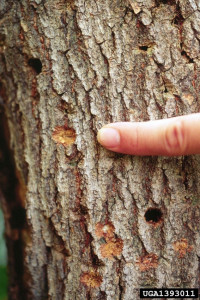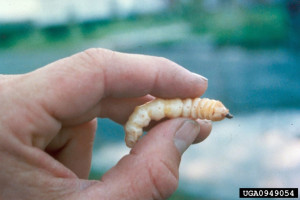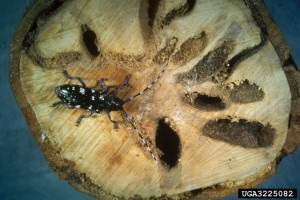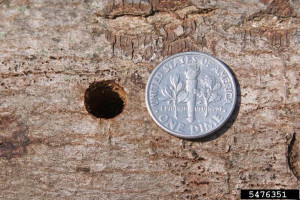In early June 2020, a homeowner near the town of Hollywood, SC, close to the coast, found an odd-looking beetle, which was sent to Clemson University’s Department of Plant Industry (DPI) for identification. Agents from the DPI identified the beetle as the invasive Asian longhorned beetle (Anoplophora glabripennis). A preliminary survey of the area found four maple trees infested with live beetles. Since that time, USDA APHIS has set up an eradication program and surveyed over 88,000 trees in the 75 square mile quarantine area.
The Asian longhorned beetle is originally from China and the Korean peninsula and has previously been found in five other states (Illinois, Massachusetts, New Jersey, New York, and Ohio). Populations in Illinois and New Jersey have been eradicated, while others continue with eradication efforts. Asian longhorned beetle (ALB) is a large (1-1.5 inches long), black beetle with white spots, long black, and white striped antennae and bluish feet (Figure 1).


In two weeks when the egg hatches, the larvae bore under the bark and begins feeding on green tissue. The larvae are large, approximately two inches long, and create the most damage by creating tunnels where it feeds inside the tree, eventually killing it (Figures 3 and 4).


These larvae can overwinter in different stages and emerge as adults at different times throughout the year, creating large round exit holes in the bark (Figure 5).

While most likely to be found in red maple trees, ALB can be found in up to 12 different host hardwood tree species, including ash, birch, buckeye, elm, poplar, sycamore, and willow. There are also several native beetles that look similar to ALB: https://resources.ipmcenters.org/view/resource.cfm?rid=18810.
The Georgia Forestry Commission is working closely with our counterparts in South Carolina to learn about this pest and what to watch for in Georgia. We are also working closely with our colleagues at the Georgia Department of Agriculture and the University of Georgia to get information out to homeowners across the eastern part of the state.
Georgia residents in coastal areas should be on the lookout for this beetle. Check your trees regularly for the insect, look for the damage it causes and report any sightings to help prevent the spread of the beetle. If infestations are reported and identified early, they can be eradicated. In Georgia, please send reports or questions to Lynne Womack (lwomack@gfc.state.ga.us). For more information on ALB, visit these two websites: https://www.aphis.usda.gov/aphis/resources/pests-diseases/asian-longhorned-beetle; https://www.invasive.org/browse/subinfo.cfm?sub=2178.
All photos are from Bugwood images.
